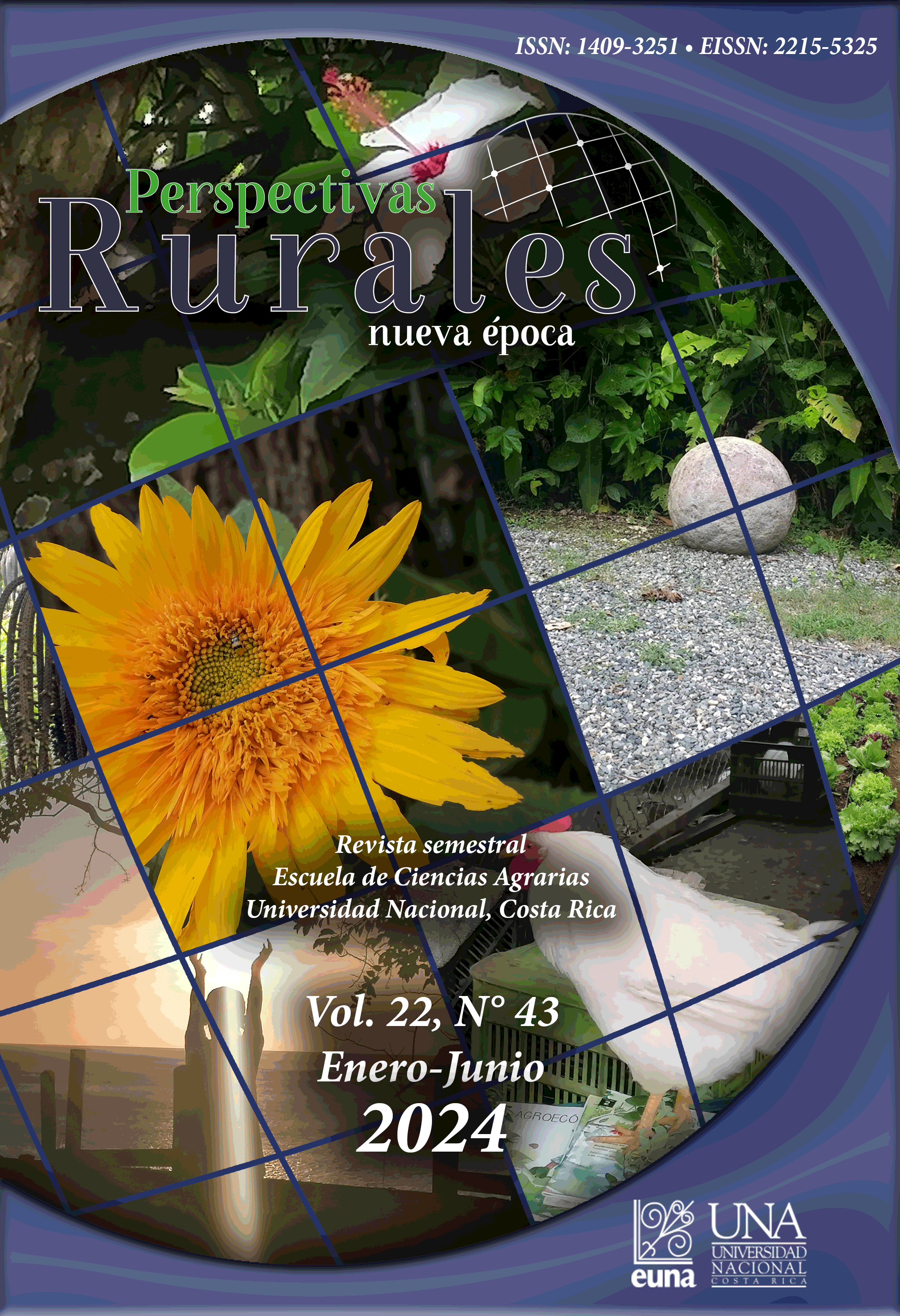Xylella fastidiosa in Costa Rica: Economic impact, agricultural relevance, and national research overview
DOI:
https://doi.org/10.15359/prne.22-43.3Keywords:
phytopathogen, coffee, Pierce disease, bacteria, palmAbstract
Xylella fastidiosa is a phytopathogenic bacterium considered a quarantine pest in crops of agricultural importance. It is associated with various diseases in crops such as: coffee, citrus, grapes, olive and ornamental species. This bacterium has negative repercussions on the export market of Costa Rica, due to phytosanitary restrictions imposed especially on the phoenix palm (Phoenix spp.). In addition, its high dispersion capacity, the existence of genetic variants and its interaction with other microorganisms make X. fastidiosa a bacterium of interest to agriculture. Currently, different research efforts are being conducted to expand the understanding about X. fastidiosa and involve the general population in the subject. This article describes the economic and social impact of X. fastidiosa on national agricultural production. Information was collected through a bibliographic review and was complemented by contributions from professionals from the Center for Cell and Molecular Biology Research (CIBCM) who currently lead research on the subject.
References
Aguilar, E., Moreira, L. y Rivera, C. (2008). Confirmation of Xylella fastidiosa infecting grapes Vitis vinifera in Costa Rica. Tropical Plant Pathology, 33(6), 444-448. https://kerwa.ucr.ac.cr/bitstream/handle/10669/76701/v33n6a07%20XF%20vitis%20CR%20TPP2008.pdf?sequence=1&isAllowed=y
Artavia-Pereira, C. y Calvo-Villalobos, F. (2021). Gestión de la continuidad del servicio ante emergencias y desastres en salud: enfoque para la reactivación productiva. Revista Internacional de Administración, 10, 116-135. https://revistas.uasb.edu.ec/index.php/eg/article/view/2854/2593
Bergsma-Vlami, M., van de Bilt, J. L. J., Tjou-Tam-Sim, N., Van-de Vossenberg, B. y Westenberg, M. (2015). Xylella fastidiosa in Coffea arabica ornamental plants imported from Costa Rica and Honduras in the Netherlands. Journal of Plant Pathology, 97(2), 391-403. https://www.researchgate.net/publication/283133084_Xylella_fastidiosa_in_Coffea_arabica_ornamental_plants_imported_from_Costa_Rica_and_Honduras_in_the_Netherlands
BeXyl Project (2023). The BeXyl Project. https://bexylproject.org/about-bexyl-project/
Castro, C., DiSalvo, B., y Roper, M. C. (2021). Xylella fastidiosa: A reemerging plant pathogen that threatens crops globally. PLOS Pathogens, 17(9), e1009813. https://doi.org/10.1371/journal.ppat.100981
Chacón, R. (2008). Identificación de microorganismos endógenos en cicadélidos y endófitos asociados a la crespera del café en el Valle Central Occidental de Costa Rica [tesis de bachillerato en Ingeniería en Biotecnología]. Instituto Tecnológico de Costa Rica. https://repositoriotec.tec.ac.cr/bitstream/handle/2238/563/TFG%20Randall%20Chacon%20C%20Biblioteca%20JFF%20TEC.pdf?sequence=1&isAllowed=y
Chatterjee, S., Almeida, R. P. P. y Lindow, S. (2008). Living in two worlds: the plant and insect lifestyles of Xylella fastidiosa. Annual Review of Phytopathology, 46(1), 243-271. https://doi.org/10.1146/annurev.phyto.45.062806.094342
Comisión Europea (2020). What is Xylella fastidiosa? Unión Europea. https://food.ec.europa.eu/plants/plant-health-and-biosecurity/legislation/control-measures/xylella-fastidiosa-es_en
Cunty, A., Legendre, B., De Jerphanion, P., Dousset, C., Forveille, A., Paillard, S. y Olivier, V. (2022). Update of the Xylella fastidiosa outbreak in France: two new variants detected and a new region affected. European Journal of Plant Pathology, 163(2), 505-510. https://doi.org/10.1007/s10658-022-02492-z
Daugherty, M. P., Zeilinger, A. R. y Almeida, R. P. P. (2017). Conflicting effects of climate and vector behavior on the spread of a plant pathogen. Phytobiomes Journal, 1(1), 46-53. https://apsjournals.apsnet.org/doi/epdf/10.1094/PBIOMES-01-17-0004-R
Esteves, M. B., Kleina, H. T., De Melo Sales, T. y Lopes, J. R. S. (2020). Selection of host plants for vector transmission assays of citrus variegated chlorosis strains of Xylella fastidiosa subsp. pauca. European Journal of Plant Pathology, 158(4), 975-985. https://doi.org/10.1007/s10658-020-02134-2
Fournier-Zumbado, S. (2007). Dinámica de la sintomatología de crespera del café y su relación con la presencia de la bacteria Xylella fastidiosa (Wells et al.) [tesis de bachillerato en Ingeniería en Biotecnología]. Instituto Tecnológico de Costa Rica. https://repositoriotec.tec.ac.cr/bitstream/handle/2238/450/fournier_zumbado_sebastian.pdf?sequence=1&isAllowed=y
Galvis-García, C. A. (2006). La crespera del cafeto. Programa de Investigación Científica. Cenicafé. https://biblioteca.cenicafe.org/bitstream/10778/900/1/avt0347.pdf
Garita, L., Villalobos-Muller, W., Zúñiga-Pereira, A. M., Álvarez-Mora, J. P., Godoy, C., Montero-Astúa, M., Chacón-Díaz, C. y Weintraub, P. (2021). Confirmation of coffee related Xylella fastidiosa vectors (Cicadellidae) in Costa Rica. Zenodo. https://zenodo.org/records/4680357
Gatgens, L. D. (09 de agosto de 2021). Proyectos - Centro de Investigación en Biología Celular y Molecular. Centro de Investigación en Biología Celular y Molecular. https://cibcm.ucr.ac.cr/proyectos/
Geering, A. y Parkinson, L. (2019). Xylella fastidiosa, a high priority biosecurity threat for the Australian avocado industry. Talking Avocados, 30(1), 1. https://static1.squarespace.com/static/57a92741d1758eb27ea55171/t/5ce4f8ee36ac2f000150a4c3/1558509809510/TAautumn2019.pdf
Giampetruzzi, A., Saponari, M., Loconsole, G., Boscia, D., Savino, V. N., Almeida, R. P. P., Zicca, S., Landa, B. B., Chacón-Díaz, C. y Saldarelli, P. (2017). Genome-wide analysis provides evidence on the genetic relatedness of the emergent Xylella fastidiosa genotype in Italy to isolates from Central America. Phytopathology, 107(7), 816-827. https://apsjournals.apsnet.org/doi/epdf/10.1094/PHYTO-12-16-0420-R
Jeger, M., Bragard, C., Caffier, D., Chatzivassiliou, E., Dehnen-Schmutz, K., Gilioli, G., Grégoire, J. C., Jacques-Miret, J. A., MacLeod, A., Navajas-Navarro, M., Niere, B., Parnell, S., Potting, R., Rafoss, T., Rossi, V., Urek, G., Van-Bruggen, A., Van Der-Werf, W., West, J., Winter, S., Tramontini, S., Andueza, M. y Candresse, T. (2016). Susceptibility of Phoenix roebelenii to Xylella fastidiosa. European Food Safety Authority Journal, 14(10), 1-11. https://efsa.onlinelibrary.wiley.com/doi/epdf/10.2903/j.efsa.2016.4600
Jiménez, L. G. y Morales-Bance, F. (1985). Distribución del mal de Pierce de la vid en Costa Rica determinada mediante la técnica Elisa. Agronomía Costarricense, 9(1), 79-83. https://www.mag.go.cr/rev_agr/v09n01_079.pdf
Landa, B. B., Saponari, M., Feitosa-Junior, O. R., Giampetruzzi, A., Vieira, F. J., Mor, E. y Robatzek, S. (2022). Xylella fastidiosa’s relationships: the bacterium, the host plants, and the plant microbiome. New Phytologist, 234(5), 1598-1605. https://nph.onlinelibrary.wiley.com/doi/epdf/10.1111/nph.18089
Montero-Astúa, M., Chacón-Díaz, C., Aguilar, E., Rodríguez, C. E. A., Garita, L., Villalobos, W., Moreira, L., Hartung, J. y Rivera, C. A. M. (2008). Isolation and molecular characterization of Xylella fastidiosa from coffee plants in Costa Rica. Journal of Microbiology, 46(5), 482-490. https://doi.org/10.1007/s12275-008-0072-8
Montero-Astúa, M., Saborío, R., Chacón-Díaz, C., Garita, L., Villalobos, W., Moreira, L., Hartung, J. S. y Rivera, C. (2007). First report of Xylella fastidiosa in avocado in Costa Rica. Plant Disease, 92(1), 1. https://doi.org/10.1094/PDIS-92-1-0175C
Montero-Astúa, M., Saborío, R., Chacón-Díaz, C., Villalobos, W., Rodríguez, C. M., Moreira, L. y Rivera, C. (2007). First report of Xylella fastidiosa in Nerium oleander in Costa Rica. Plant Disease, 92(8), 1. https://doi.org/10.1094/PDIS-92-8-1249A
Morelli, M., García-Madero, J. M., Jos, A., Saldarelli, P., Dongiovanni, C., Kovacova, M., Saponari, M., Baños-Arjona, A., Hackl, E., Webb, S. y Compant, S. (2021). Xylella fastidiosa in olive: a review of control attempts and current management. Microorganisms, 19(8), 1771. https://www.researchgate.net/publication/354036254_Xylella_fastidiosa_in_Olive_A_Review_of_Control_Attempts_and_Current_Management
Nunney, L., Ortiz, B., Russell, S., Sánchez, R., y Stouthamer, R. (2014). The complex biogeography of the plant pathogen Xylella fastidiosa: genetic evidence of introductions and subspecific introgression in Central America. PLOS ONE, 9(11), e112463. https://www.kerwa.ucr.ac.cr/bitstream/handle/10669/76266/journal.pone.0112463%20BO%20RRS%20XF.pdf?sequence=1&isAllowed=y
Pest Organisms Threatening Europe [POnTE]. (2017). The University of Costa Rica organizes a workshop on the Xylella fastidiosa host status of P. roebelenii palm. POnTE Project. https://www.ponteproject.eu/conferences/university-costa-rica-organises-workshop-xylella-fastidiosa-host-status-p-roebelenii-palm/
Rapicavoli, J., Brian, I., Blanco‐Ulate, B., Cantu, D. y Roper, C. (2018). Xylella fastidiosa: an examination of a re‐emerging plant pathogen. Molecular Plant Pathology, 19(4), https://bsppjournals.onlinelibrary.wiley.com/doi/epdf/10.1111/mpp.12585
Servicio Nacional de Sanidad, Inocuidad y Calidad [SENASICA] (2022). Xylella fastidiosa subsp. fastidiosa Wells et al., 1987. https://www.gob.mx/senasica
Servicio Fitosanitario del Estado [SFE]. (2015, 03 de agosto). Gobierno decreta emergencia fitosanitaria por Xylella fastidiosa [comunicado de prensa]. https://www.sfe.go.cr/Prensa2015/16%20Gobierno%20decreta%20emergencia%20fitosanitaria%20por%20Xylella%20fastidiosa.pdf
Servicio Fitosanitario del Estado [SFE]. (2022, 22 de febrero). UE autoriza reanudación de exportaciones de plantas ornamentales afectadas por medida fitosanitaria [comunicado de prensa]. https://www.sfe.go.cr/Prensa_2022/03%20UE%20autoriza%20reanudaci%C3%B3n%20de%20exportaciones%20de%20plantas%20ornamentales.pdf
Sicard, A., Zeilinger, A. R., Vanhove, M., Schartel, T. E., Beal, D. J., Daugherty, M. P. y Almeida, R. P. (2018). Xylella fastidiosa: insights into an emerging plant pathogen. Annual Review of Phytopathology, 56(1), 181-202. https://www.annualreviews.org/doi/pdf/10.1146/annurev-phyto-080417-045849
Vargas-Cartagena, L., Sánchez, E., Vargas, M., Solórzano, A., Hernández, F., Iwasawa, H. y Freer, E. (2002). Presencia de bacterias en el xilema de cafetos (Rubiaceae: Coffea arabica) afectados por la enfermedad conocida como “crespera”. Revista de Biología Tropical, 50(1), 45-48. https://revistas.ucr.ac.cr/index.php/rbt/article/view/16151/15604
Villegas-Rojas, M. (2016). Informe de vigilancia tecnológica sobre Xylella fastidiosa. Vicerrectoría de Investigación, Universidad de Costa Rica. https://kerwa.ucr.ac.cr/bitstream/handle/10669/29516/Informe%20Xf%20final.pdf?sequence=1&isAllowed=y
Voigt, K., Marano, A. V. y Gleason, F. H. (2013). Ecological and economical importance of parasitic zoosporic true fungi. En: F. Kempken (ed.), The Mycota (vol. 11). Springer.
Yoon, S. y Lee, W. (2023). Spatial analysis of climatic and dispersion characteristics of Xylella fastidiosa outbreak by insect vectors. Journal of Asia-Pacific Entomology, 26(1), 102011. https://doi.org/10.1016/j.aspen.2022.102011
Downloads
Published
How to Cite
Issue
Section
License
Copyright (c) 2024 Rachelle Fernández Vargas y Luis Navarro Flores

This work is licensed under a Creative Commons Attribution-NonCommercial-NoDerivatives 4.0 International License.
![]()
Revista Perspectivas Rurales. Nueva Época se encuentra bajo una licencia Creative Commons Reconocimiento-NoComercial-CompartirIgual 4.0 Internacional License.
Creado a partir de la obra en http://www.revistas.una.ac.cr/index.php/perspectivasrurales
Los autores/as que publiquen en esta revista aceptan las siguientes condiciones:
- Los autores/as conservan los derechos de autor y ceden a la revista el derecho de la primera publicación, con el trabajo registrado con la Licencia Creative Commons Atribución-NoComercial-CompartirIgual 4.0 Internacional, que permite a terceros utilizar lo publicado siempre que mencionen la autoría del trabajo y a la primera publicación en esta revista.
- Los autores/as pueden realizar otros acuerdos contractuales independientes y adicionales para la distribución no exclusiva de la versión del artículo publicado en esta revista (p. ej., incluirlo en un repositorio institucional o publicarlo en un libro) siempre que indiquen claramente que el trabajo se publicó por primera vez en esta revista.
- Se permite y recomienda a los autores/as a publicar su trabajo en Internet (por ejemplo en páginas institucionales o personales) antes y durante el proceso de revisión y publicación, ya que puede conducir a intercambios productivos y a una mayor y más rápida difusión del trabajo publicado.






